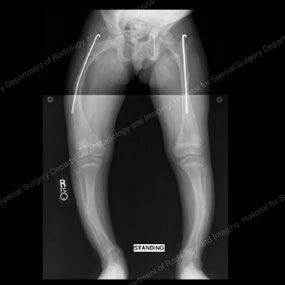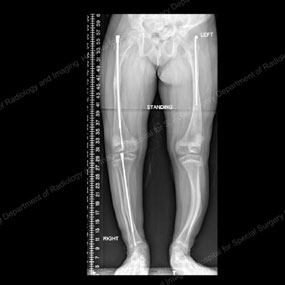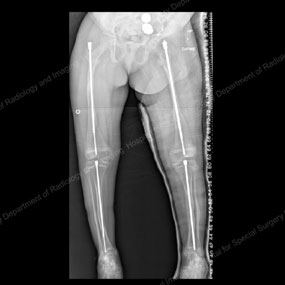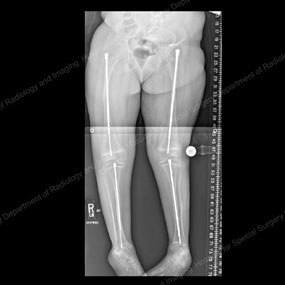How to Transport a Baby With Brittle Bone Disease
Introduction to Osteogenesis Imperfecta
Osteogenesis imperfecta (OI) is a genetic disorder characterized past frail bones that break easily, leading to associated deformities. This condition results from an inability to produce either sufficient or normal quality blazon I collagen, an essential component of healthy bone.
The severity of OI varies considerably, with some children experiencing fractures in infancy and others in whom the disorder remains undetected until a series of fractures signals the demand for evaluation. Infrequently, a patient reaches adulthood without being aware that they have a mild grade of OI.
Although specialists in the field recognize that there may be even more variations of the disease than formerly recognized, currently, well-nigh OI diagnoses are categorized equally one of the following types.
- Type 1: the mildest and about common form of OI
- Type 2: a severe course of the illness, oftentimes affecting a fetus in utero
- Type 3: a progressive, deforming blazon of OI, or
- Blazon 4: a moderate form of the status
In add-on to fractures, children with this condition may have ligamentous laxity (loose ligaments), muscle weakness, a tendency toward spinal curvature, and breakable teeth. Short stature - and in some cases severe growth retardation - is as well a hallmark of OI.
All the same, other medical problems may also be present at nascence or develop during childhood, including respiratory difficulties resulting from rib cage deformities and underdevelopment of the lungs. Some people with OI may experience hearing loss (normally in their 20'south) and/or tinted sclera (the whites of the eyes) due to the thinness of the sclera, which is composed of Blazon 1 collagen and allows the low-cal to exist reflected through the eye. The cornea is also thinner, which needs to be considered in patients who crave eye surgery.
Because children with OI often have numerous medical needs, a number of specialists may be involved in their care. "A multidisciplinary approach offers the all-time chance for reducing the number of fractures the child experiences, addressing deformity, maximizing function, and improving quality of life," says Daniel W. Light-green, MD, MS, FAAP, FACS, Associate Attending Orthopedic Surgeon at Hospital for Special Surgery (HSS).
At HSS, this means that orthopedists work equally a team with pediatricians, pediatric concrete therapists, genetic counselors, nurses, social workers and nutritionists. Much of this care is delivered through the Kathryn O. and Alan C. Greenberg Center for Skeletal Dysplasias nether the management of Cathleen L. Raggio, MD, Banana Attending Orthopedic Surgeon at HSS and Co-Managing director of the Center, and Jessica 1000. Davis, MD, an Associate Attention Pediatrician at HSS and Co-Managing director of the Centre and Director of the Sectionalisation of Human being Genetics at Weill Cornell Medical College.
"Fortunately, new advances in surgical technique and tools, combined with medication and physical therapy, are changing the course of this disease for many children," Dr. Green says.
Treatment for Osteogenesis Imperfecta: A History
Leon Root, Doc, attention orthopedic surgeon and former Chief of Pediatric Orthopedics at HSS, as well every bit a main investigator in some of the kickoff clinical studies of children with osteogenesis imperfecta, describes some of the early breakthroughs in the field. "Some of our initial attempts to strengthen the bone involved giving OI patients magnesium sulfate, which we thought might alter the action of an enzyme they produce that nosotros thought to be part of the disease process. In doing so, we hoped to change the form of the disease."
Other trials from this era involved hormone therapy, steroids, and loftier doses of vitamin C and calcium.
When these trials failed to yield any constructive therapy, Dr. Root and his colleagues looked to surgical intervention, developing a procedure which involved segmenting the bone and inserting a long rod through the segments. "The rod acted as an internal strut, protecting the os against fractures and allowing some children to walk for the kickoff time," Dr. Root says. Bone biopsies obtained during these early on rodding surgeries also allowed orthopaedic surgeons to learn more almost what constituted "normal" bone in OI patients and to proceeds a greater understanding about their collagen structure.
Despite the advances offered by rodding surgery, at that place were drawbacks besides. Children eventually outgrew the rods and fractures developed at the ends of the os. "This meant that the process had to be repeated every few years," explains Dr. Root. Since that fourth dimension, more sophisticated, telescoping rods have been developed, helping surgeons obviate that problem. (see Surgical Treatment for OI, below.)
Osteogenesis Imperfecta Not-surgical Treatment
Drug Therapy:
Although at that place is still no cure for osteogenesis imperfecta, many patients tin now derive significant protection against fracture through drug therapy. "All individuals make osteoblasts, which are cells that build new os, and osteoclasts, which are cells that are responsible for removing or breaking down bone," explains Dr. Raggio (who, in addition to treating patients, conducts laboratory studies in OI.) "This process takes identify throughout growth and, to a lesser extent, after a person reaches skeletal maturity. Patients with more severe forms of OI tend to take a very high turnover of bone."
Bisphosphonates, drugs that were originally developed for the treatment of osteoporosis and certain cancers, wearisome downwardly the rate at which osteoclasts accept bone away, providing the patient with protective scaffolding, which is actually calcified cartilage, according to Dr. Raggio. (Because the activeness of the drug is related to turnover, bisphosphonates are not every bit helpful in mild cases of OI - in which turnover is slower - and in patients who have stopped growing.)
In patients who are appropriate candidates, therapy should exist initiated as early every bit possible, Dr. Raggio says. Children as young every bit one to two months tin can receive IV infusions of a bisphosphonates in the infirmary setting. Equally the child becomes older, the drug is administered orally, the bisphosphonate dose may exist reduced, and the intervals betwixt doses may get less frequent.
"Most children tolerate these drugs very well, but we do follow them carefully with the assist of a pediatric endocrinologist," (a dr. who specializes in hormonal and metabolic disorders), says Dr. Dark-green. The patient'due south claret and urine are tested regularly for calcium phosphorus and the products of collagen. DEXA scans (a blazon of X-ray) which assess bone quality are taken every six months in immature children then annually when the child reaches three or four years of age.
Both Dr. Light-green and Dr. Raggio emphasize the need for an individualized approach with each patient. "Some patients may do good from bisphosphonates therapy early on on and may not do so afterwards," says Dr. Raggio. "In addition," she continues, "we want to exist watchful of the long-term effect on the bone."
Owing to a careful choice process, most patients on bisphosphonates therapy at HSS practise well. Nevertheless, according to Dr. Dark-green, in those less frequent cases where at that place is no improvement subsequently a twelvemonth, the drug is discontinued. Bisphosphonates take been shown to interfere with the normal healing procedure later a surgical osteotomy and therefore, bisphosphonate therapy needs to be discontinued prior to and afterward the surgery until it is established that the os is healed.
Surgical Handling for Osteogenesis Imperfecta - Fassier-Duval Nailing
Although orthopedic intervention for osteogenesis imperfecta tin can include bracing to assist protect the patient during physical activeness and physical therapy, surgery with intramedullary (in-bone) fixation to correct deformity offers the greatest long-term do good and protection confronting future fracture.
Intramedullary Fixation
Historically, orthopedists used rods of a fixed length to help fractures heal and avert or correct deformity. All the same, as the child grew, he or she was at risk for fracturing the leg immediately below the rod. Today, pediatric orthopedists at HSS are using the Fassier-Duval Telescopic Intramedullary Organisation, a relatively new form of instrumentation designed specifically for patients with OI who are all the same growing.
Fassier-Duval Telescopic Intramedullary System
Fassier-Duval rods are secured on the far end of each growth plate and telescope, or extend, as growth in the bone occurs. Following the initial placement, there is often no demand for surgical adjustment while the child grows. The patient is therefore less likely to develop the type of fractures associated with older, non-telescoping rods, and may require fewer surgeries as well.
The development of the Fassier Duval nails accept helped transform the nature of surgery, as these telescoping rods "grow" along with the child. "This tin can mean a reduction in the number of surgeries the kid needs," says Dr. Greenish.




This serial of 10-rays depicts the surgical progression addressing the needs of a growing child with OI. In the top left pic she was treated with intramedullary rods. However, every bit she outgrew these rods and approached the time of rapid growth, her rods were replaced with Fassier-Duval rods (bottom two ten-rays). Fassier-Duval rods provide stability for the fragile bones, allow for correction of bowing, and grow (lengthen) as the child grows. [To follow her progress, begin with the acme left image, followed past the upper right, lower left, and lower right. Click on each prototype to view a larger version.]
Physical Therapy for Osteogenesis Imperfecta
Regardless of the blazon of treatment they receive, maintaining or improving muscle and bone strength are goals for all children with osteogenesis imperfecta. But concrete therapists besides work closely with families of patients, especially those with newly diagnosed newborns. "Parents ofttimes need assist in learning how to carry and handle their infants," explains Frances Baratta-Ziska, PT, MS, who is a physical therapist at HSS. "We teach them how to safely allow the child to explore the surroundings, every bit well every bit to how to dress and modify them in a manner that protects them from fractures."
As their immature patients grow, Ms. Baratta-Ziska, and her colleague, Magda Oledzka, PT, Pediatric Section Managing director in the Rehabilitation Section at HSS, assistance them go along to motility safely and teach them about the importance of avoiding jarring movements, jerking, and twisting. "Because children with OI can fracture their limbs with everyday move, our goal is to teach them means to exist agile and develop skills in the safety of the PT setting, then they will experience more confident exterior the infirmary," says Ms. Baratta-Ziska.
"Regardless of the level of mobility children with OI are able to reach, nosotros find that those who do all-time accept been incorporated into family life, instead of family unit life revolving around them," adds Ms. Oledzka. She cites the many creative ways families make adaptations to assistance the child with OI participate in a range of activities, including travel.
In addition to improving the quality of daily life, concrete therapy is an especially of import component of care post-obit rodding surgery or other procedures resulting from fractures. "Muscle mass decreases in any person who is immobilized," explains Ms. Baratta-Ziska, "so postal service-surgical therapy can be intensive. We see the patients two or three times a week and give them safety exercises to regain their strength."
As OI patients achieve adolescence there tends to be a reduction in fractures, although the reason for this is not nonetheless clearly understood. Even so, new issues arise. "Teenagers and higher-jump patients decide whether they desire to keep with concrete therapy," says Ms. Baratta-Ziska. "Some opt to go along walking, while others find they can participate more than easily at schoolhouse and other activities by using a wheelchair." In addition, she notes, some teenaged patients develop weight control problems. "Considering weight gain may issue in less movement and is hard on the joints, we frequently work with a nutritionist who works with the patients to make better nutrient choices," says Ms. Oledzka.
Genetic Counseling for Osteogenesis Imperfecta
Genetic counseling too plays a key role in the treatment of osteogenesis imperfecta patients and their families at HSS, specially for the newly diagnosed.
"Parents of a new baby with OI come to the states with many questions: 'How did this happen and why? What are the chances that it will happen with another infant? Where do we get from here?'" says Erin Carter, MS, CGC, the clinical coordinator and genetic counselor at the HSS Kathryn O. and Alan C. Greenberg Middle for Skeletal Dysplasias, who spends much of her time answering those questions and explaining the genetic origins of the illness.
"The majority of cases of OI are acquired past autosomal dominant mutation in ane of the genes that code for blazon I collagen," she explains. "Usually, when no i else in the family has a history of OI, a spontaneous change, or mutation, occurred in the genes either in the sperm or in the egg earlier conception or shortly afterward (in the fertilized eggs). In the majority of these families, with no history of OI, who then have a child with OI, in that location is a negligible chance of having another child with the aforementioned affair."
Occasionally, Ms. Carter says, she also encounters individuals with mild forms of OI who did not realize they had OI until their own child was diagnosed. Genetic counseling is also important to people who have OI who wish to become parents. "Individuals with OI who have a baby with a partner who does not have OI have a 50% chance of having a child with OI with each pregnancy," she says.
In addition to explaining the genetic groundwork and implications of OI on family planning, Ms. Carter serves as inquiry coordinator in a number of Dr. Raggio's clinical trials and helps patients and families deal with insurance providers to obtain coverage for genetic testing.
Looking to the Time to come of Osteogenesis Imperfecta
"Fortunately, over the last ten years the prognosis for children with osteogenesis imperfecta has improved considerably," says Dr. Green. "Through a combination of intramedullary fixation, timely surgical intervention, medication, and physical therapy, children now accept the opportunity to achieve very proficient function. In some cases, this includes the ability to walk, which might not have been a possibility in the past."
The hereafter of OI treatment likewise continues to expect promising. Dr. Raggio and her colleagues at HSS are presently conducting animal studies of a new class of drugs known as RANKL inhibitors. "Instead of rendering osteoclasts less effective, these drugs interfere with the formation of osteoclasts," Dr. Raggio explains. She is likewise studying parathyroid hormone (PTH), a bone stimulator that may be useful in some developed patients with OI who are not proficient candidates for bisphosphonates therapy.
Taking the longer view, Dr. Root anticipates that cell therapy and cistron manipulation may somewhen lead to dramatic advances in OI treatment.
Read almost Lauren Davidson, an HSS patient with osteogenesis imperfecta who went on to get a swimming medalist.
For more information on treatment of osteogenesis imperfecta at HSS, please phone call our Md Referral Service at ane.877.606.1555.
Updated: 10/12/2011
Summary past Nancy Novick
Authors
How to Transport a Baby With Brittle Bone Disease
Source: https://www.hss.edu/conditions_osteogenesis-imperfecta-approach-to-treatment.asp